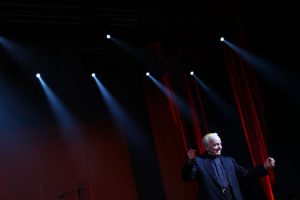Still from First Cow, by Kelly Reichardt. FilmAffinity
In modern cinema, directors are once again feeling the pull of the Westerns of yesteryear, proof that this mythical vision of the American epic still lives on.
The Dead Don’t Hurt, starring Viggo Mortesen, is one of the latest examples, while Kevin Costner has also breathed new life into the genre in Horizon: An American Saga. The Western has risen from the ashes of disinterest in the early 21st century, and as with all revivals, there are aspects of the tradition that endure while others are reassessed.
On the one hand, this phenomenon of re-appropriating the Western is a clear, intentional aesthetic choice: stagecoaches, wagons, ramshackle towns, ranches, tumbleweeds, saloons, stables and deserts are still mainstays of this cinematic world. It was in these spaces that the first Westerns told the tales of heroism that would come to to define “American” identity.
At the same time, American war films have often aimed for something similar, albeit in a more tragic vein – once the conquest of the West was complete, these same people and values would go out to assume the role of “sheriff” on a global scale. The parallels are striking: heroes risk their lives on the frontiers of ideology and religion to defend the Law against rogue agents, presenting democracy and freedom as the only political bulwark against the power of the strongest, in a more tarnished and critical interpretation of the Western vision.
While not everything can be boiled down to a handful of romantic clichés, one of the Western’s most valuable aspects is its creation of human archetypes like the “frontiersman”, as depicted by Ethan Edwards in The Searchers. Edwards embodies heroism and the ethical positions of outsider and outlaw that do not necessarily fit neatly together. Later, this mould of the “apparently bad but ultimately good guy” would vindicate Clint Eastwood’s protagonist in Unforgiven.
In the modern incarnations of the Western, the allure of these old archetypes is still extremely powerful.
The history of the Western
The Western began as a literary genre, created by East coast puritan colonisers under the doctrine of “manifest destiny”.
Spread by journalists such as John O’Sullivan, this idea legitimised and justified westward territorial expansion as a momentous duty for citizens of democracy. Indeed, many Westerns owe a debt to the work of the press – it features prominently in the plot of 2020’s News of the World, which tells the story of a young girl held captive by Native Americans.
John Wayne in a still from The Searchers, by John Ford.
FilmAffinity
The genre has also documented and established historical landmarks. Events such as the completion of the first transcontinental railroad to California, the Civil War – which paralleled the Union and the fight against slavery – the annexation of Texas and its bids for independence, and the creation of Indian reservations are some of the milestones that bound the country together with a shared narrative of courage, contradiction, sacrifice and innovation.
Similarly, the Western is inseparable from the birth of cinema. The characters depicted by authors like Bret Harte would later appear on screen in a mythology populated by bandits, outlaws, trappers, sheriffs, outsiders and cowboys – people with expansionist, adventurous interests, driven by necessity or greed.
Another great theme of the Western is the whitewashing or excusing of criminal behaviour, particularly in the “dime novels” that were popular among children, where the frontier becomes a mental, spiritual and political symbol. Here, moral scepticism and ambiguity coexist in heroes with a fierce code of honour: John Ford, Howard Hawks, Sam Peckinpah, Anthony Mann, Sergio Leone and John Sturges were but a few classic directors who reinvented the figure of the knight-errant on the prairies.
The Western is therefore a narrative formula that explains the forging of a nation, while also nourishing, correcting, orienting and questioning it. The Western is to America what tragedy is to Ancient Greece.
Remakes, adaptations, and stories of everyday life
After briefly falling out of fashion in the late 20th century, the Western has experienced a new lease of life, built on homage to the genre with a renewed focus on demystifying ordinary life in this period of history.
Admiration for heroic sacrifice can be seen in remakes like 3:10 to Yuma or True Grit, while novels and biographies have been adapted for the big screen to show the negative consequences of violence. There is room for the stories of Civil War renegades in The Assassination of Jesse James by the Coward Robert Ford, as well as capitalism’s more abhorrent sides in the incomparable There Will Be Blood.
Still from The Assassination of Jesse James by the Coward Robert Ford, by Andrew Dominik.
FilmAffinity
This revival of the genre brings a touch of critical modernity: the nation-building attitude and harsh living conditions of the pioneers are deconsecrated, no longer the stuff of romance.
Instead, stories like that of Hugh Glass in The Revenant reflect the real struggle of man against nature’s more savage forces in the frontier territories. Even new protagonists, such as Captain Joseph Blocker in Hostiles, show the psychological wounds inflicted by the protagonist’s own violent acts.
There have also been bolder, more novel approaches, such as that of Quentin Tarantino’s Django Unchained, a film with a rare (though not unique) black protagonist where violence becomes language, or that of Tommy Lee Jones in The Homesman, which paints a decidedly unheroic portrait of women who return to the East because they were unable to endure the tough conditions out West.
Striking a more celebratory tone, the figure of the explorer Martha Jane Canary-Burke, known as “Calamity Jane”, is idealised in a film of the same name.
French animated film Calamity retells this story in a picturesque compendium of the themes that dominate the great American story. Director Rémi Chayé approaches the myth of Martha Jane Cannary by intelligently distilling the essence of the Western: the interplay of a physical and psychological journey, the hero’s loneliness in the face of danger, the sense of community, the yearning for adventure and the romance of the everyday, the mystique of coffee over a campfire, and the voracious beauty of an untamed wilderness that does not spare the weak.
Still from Calamity, by Rémi Chayé.
FilmAffinity
Ploughing a more contemplative furrow, director Kelly Reichardt documents the time of the Western, recognising the value of uncertainty and de-dramatising the everyday lives of hustlers and their families in Meek’s Cutoff and First Cow.
The Western has been reborn in the 21st century, demystifying its motives and questioning – not without nostalgia and admiration – some of the darker aspects of a history that is still being unmasked, and of a bewitching, cruel and enchanting fantasy portrayal of migration.
The authors of this article have recently published a book in Spanish entitled «El western renacido en el siglo XXI» (The rebirth of the Western in the 21st century), which compiles 15 studies on 21st century Westerns.
Alberto Fijo Cortés y Gema Pérez Herrera no reciben salarios, ni ejercen labores de consultoría, ni poseen acciones, ni reciben financiación de ninguna compañía u organización que pueda obtener beneficio de este artículo, y han declarado carecer de vínculos relevantes más allá del puesto académico citado.




